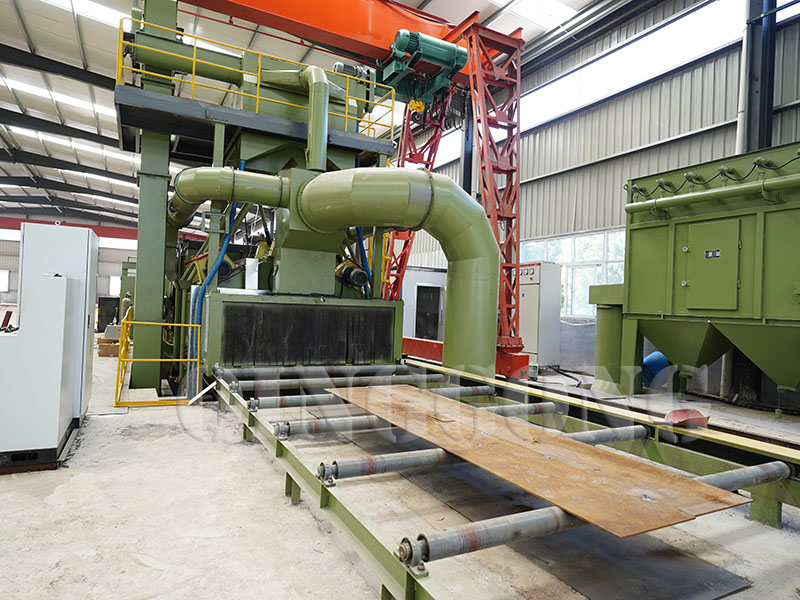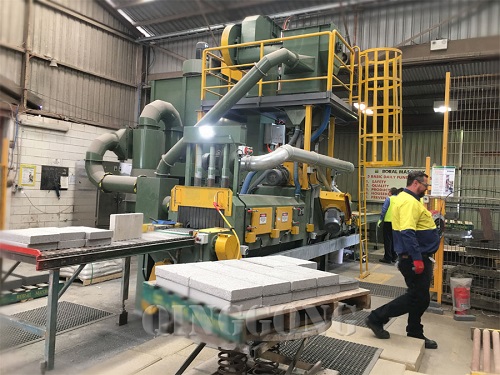The dust removal system and the ventilation in the sandblasting room are to absorb the dust generated in the blasting cleaning process in time, to reduce the dust concentration in the blasting room, and to improve the indoor visibility, the working environment of the blasting workers, which is conducive for the workers to control the quality of blast cleaning and to improve production efficiency.
The ventilation method of the sand blasting room
There are two methods of sandblasting room ventilation: the vertical ventilation and horizontal ventilation. The horizontal ventilation is generally used in sand blasting rooms with large particles, and it requires less ventilation than the vertical ventilation. The ventilation speed in the cleaning room should be sufficient to remove the dust generated during the blast cleaning process effectively, and its size depends on the amount of dust generated by the abrasive used.
The calculation method of the ventilation in blasting room
There are generally two calculation methods for ventilation in the sand blasting room. One is to calculate the ventilation according to the ventilations rates. The other one is to calculate the ventilation according to the wind speed on the cross section of the sand blasting room. The large-scale sand blasting room uses the first method to calculate the ventilation volume more than the second, and there is no standard for the ventilation rates. The less can be only 5 times / H, while some foreign sand blasting rooms have the ventilation rates up to 20 times / H.
The second calculation method is mostly used for the ventilation of the small or the medium shot blasting rooms. The wind speed on the cross-section is different from the abrasive used. If any abrasive that is easily broken and has a large amount of dust is used, the ventilation speed will be higher. Otherwise, the ventilation speed can be lower. The sand blasting room with steel sand or steel shot as the abrasive has the least ventilation. The dust content is very high in the air of the sand blasting room’s ventilation devices, and it needs to be purified before it can be discharged into the atmosphere. The device used to purify the dusty air is our dust removal system, which is common to see. The device used to purify dusty air is the dust removal system, which is common to see. The ventilation and dust removal systems that can be used in sand blasting rooms are cyclone dust collectors, bag dust collectors, and so on.
FAQs about Ventilation System
1. How does the ventilation system control dust and airborne particles?
The ventilation system creates a negative pressure environment within the sandblasting room, ensuring that airborne particles are effectively captured and removed by the exhaust system. Air filters help trap particulates before clean air is reintroduced into the workspace.
2. What components make up a typical ventilation system in a sandblasting room?
A ventilation system usually includes:
Exhaust Fans: To draw contaminated air out of the sandblasting room.
Ductwork: Channels air from the room to the outside environment.
Air Filters: Remove particulates and contaminants from the air before it is exhausted.
Make-up Air System: Provides fresh air to replace the exhausted air, maintaining proper air balance.
3.What are the safety considerations when designing and operating a ventilation system for sandblasting rooms?
Ensuring proper maintenance of exhaust fans and filters to prevent buildup of hazardous materials.
Regular monitoring of air quality and ventilation effectiveness.
Compliance with safety regulations and standards regarding ventilation in industrial environments.
Providing personal protective equipment (PPE) such as respirators for operators as an additional safety measure.
 EN
EN
 fr
fr  de
de  es
es  it
it  ru
ru  pt
pt  ar
ar  th
th  pl
pl  ro
ro 


